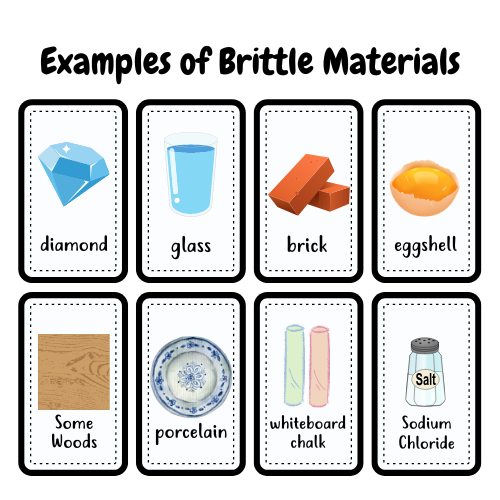Fragility refers to the ability of certain materials to fracture or break into smaller pieces with little or no deformation. This property is closely related to the appearance and propagation of cracks in the material. Some examples of brittle materials include: diamond, brick, crystal, and graphite.
The level of deformability in a material determines its brittleness. Elastic and ductile materials have low brittleness, as elastic materials can recover their shape without breaking after being deformed by force, and ductile materials can deform without breaking.
Toughness is the opposite of brittleness, representing a material’s resistance to being broken, bent, or torn.
Brittleness vs. Hardness
It is essential not to confuse brittleness with hardness. Brittleness is related to a material’s tendency to fracture into small parts, while hardness refers to the resistance a material offers to having its surface scratched.
What are Brittle Materials Used for?
Since brittle materials can only absorb a limited amount of energy before breaking, they are generally not desirable for constructing durable objects like foundations or bridges. However, brittle materials find applications in various industries, such as:
- Making certain components of electronic devices.
- Jewelry decoration.
- The optical industry.
- Household items, such as tableware.

Examples of Brittle Materials
- Diamond: The hardest known material composed of carbon atoms with a rigid structure. While very hard, it can still break into smaller fragments and cannot be deformed.
- Glass: A verifiable example of a brittle material in everyday life. When dropped on the ground, glass fractures into small pieces, which makes it useful for applications like fire extinguisher boxes or bus windshields.
- Brick: Widely used in construction, brick is a usually rectangular and hollow piece made of baked clay.
- Ceramics: Objects made from earthenware, mud, clay, or other materials that become hard and brittle after firing. They are often used for ornamental or funerary purposes.
- Some Polymers: Thermosetting polymers can exhibit brittle fractures. For example, polystyrene.
- Eggshell: Composed of calcium crystals and protein, eggshells fracture into smaller parts with a single blow.
- Crystals: Solids with particles regularly arranged in their structure. They can be formed in various ways, such as when vapor comes into contact with a cold surface.
- High Carbon Steels: While steel is typically ductile and tenacious, high carbon steels with excessive carbon content can become brittle.
- Porcelain: A white, compact, waterproof, and hard material used for making tableware, vases, lamps, and ornamental objects.
- Whiteboard Chalk (Pastel): A brittle, dusty white clay used for writing on blackboards and cleaning some metals when pulverized.
- Dry Plaster: A colorless calcium sulfate mineral used with water for construction or modeling work, but it becomes brittle as it loses water and hardens.
- Graphite: A mineral made up of superimposed layers of graphene, it is black, soft, opaque, and fragile. It is commonly used in pencil tips.
- Some Woods: Different types of wood have varying elastic properties, with some being more brittle and easy to splinter, like balsa wood or decayed wood.
- Tin-rich Bronzes: Bronze, an alloy of copper and tin, is usually ductile and malleable. However, high tin content can make it brittle.
- Sodium Chloride (NaCl): The crystals of this salt are brittle and easily fracture into smaller pieces.